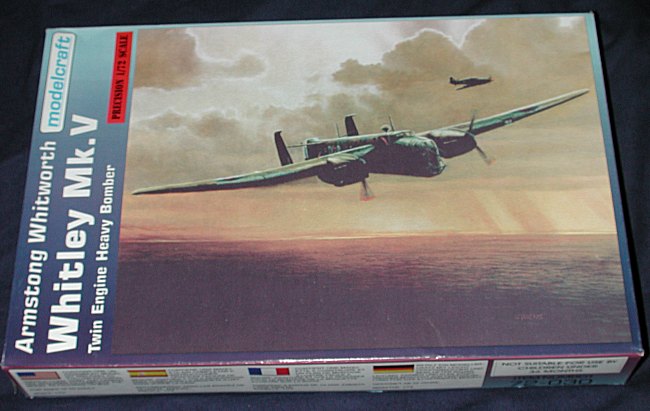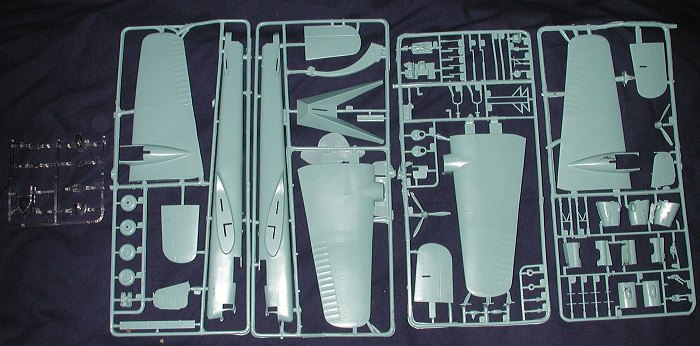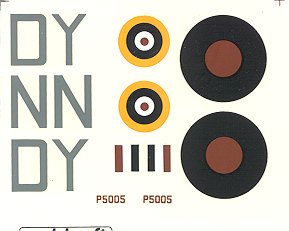
|
KIT: |
Modelcraft 1/72 Whitley Mk. V |
|
KIT # |
72-030 |
|
PRICE: |
$11.98 |
|
DECALS: |
One aircraft |
|
REVIEW & |
|
|
NOTES: |
Ex-Frog mold |

|
HISTORY |
When one thinks of ugly bomber, the Whitley comes to mind. While not quite as bad as many of the prewar French designs, it is right up there. When one adds to this the nose down flying attitude of the aircraft, then one does have very odd looking aircraft, especially in flight. This nose down attitude is caused by the preset angle of attack of the wing. It makes it quite an easy aircraft to take off and land, but does give it the distinctly unnerving flight attitude. I would think that crew members were always feeling as if they were about to slide out of their seats.
Regardless, the Whitley was one of the three major bomber types along with the Wellington and Hampden the Britain entered the war with. Unlike the others, the Whitley was always used as a night bomber. This was possibly because of its rather sedate performance or relatively light bomb load or perhaps both. In any rate, it was used for most of the early war leaflet missions as well as for relatively long range recce missions.
Initiallyl designed in the early 30's , the Whitley prototype first flew in 1935. Construction of the aircraft continued until mid 1943, despite the obvious obsolescence of the type. The Mk. V was the built in greater numbers than any other with production of the type beginning in 1939 and continuing until production ceased. A very similar Mk.VII was developed for Coastal Command. After the first year of the war, many Whitleys were converted as troop carriers, target tugs and glider tugs.
|
THE KIT |

Modelcraft is a Canadian company known for producing not only their own line of aircraft, but of reboxing Russian Novo kits. These Russian kits all started life as Frog molds back in the 60's and early 70's. The Whitley is one of those later molds and as such, does not suffer as badly as many other old Frog kits from a case of flash. While there is still quite a bit of it to be found, it isn't that bad.
If you have never built a Frog kit or any of the various reboxings, then you have missed what plastic modeling was like back 30+ years ago. Back then, the main thing was to have a fairly accurate kit that could be built in a relatively short time. Though operating features were the norm in the early years, Frog started getting away from that in their later years.
Just about all detailing of any kind was limited to the outside. Engraved lines were limited to control surfaces and doors/hatches. The kit comes with aircrew, something that went away from kits for a number of years and continues like that even today.
This kit is molded in a rather odd turquoise plastic. Most detailing is by raised lines and the clear bits are quite thick. Detail in the interior sections are almost non-existent, so that one has lots of room to add scratchbuilt detail. In addition to some flash, the mold seams on some sprues is a bit much and my kit has a broken prop. Where the blade went is an unknown as it wasn't in the bag. Speaking of the bag, the parts were in a waxed paper bag that wasn't sealed. The box is one of those miserable donut boxed that everyone hates.
 Instructions
are a direct copy of the Frog instructions sheet. That means that they are
adequate to the task. No painting information is given for any interior bits,
even though the little pictograms show that painting is needed. The other side
of the sheet is a three view of a night bomber of 4 group RAF. The squadron is
not given. Exterior painting information is given along with colors in FS 595
standard. The decals themselves and glossy and don't look that bad at all.
Perhaps a reader can clue us as to what squadron the decals represent.
Instructions
are a direct copy of the Frog instructions sheet. That means that they are
adequate to the task. No painting information is given for any interior bits,
even though the little pictograms show that painting is needed. The other side
of the sheet is a three view of a night bomber of 4 group RAF. The squadron is
not given. Exterior painting information is given along with colors in FS 595
standard. The decals themselves and glossy and don't look that bad at all.
Perhaps a reader can clue us as to what squadron the decals represent.
Editor's Note: No sooner was this preview published, than reader Derek Horne sent in info on the markings. "The kit reviewed represents a very famous aircraft of 102 Squadron flown by P/O Leonard Cheshire. He flew this a/c back from Cologne with a huge hole in the fuselage after they were caught by flak and was subsequently awarded the DSO. The machine was repaired and passed to 19 OTU based at RAF Forres in Scotland (70 miles from here) and was written off on a training flight in June 1942, crashing into a cloud covered hillside." Thank you, Derek.
Overall, it isn't a bad kit, but it also isn't a great one. It has the distinction of being the only injected Whitley in any scale, so if you want one, this is it.
|
REFERENCES |
Aircraft of the Royal Air Force since 1918 by Owen Thetford, Putnam, 1979, 7th Edition
Review kit courtesy of me and my wallet!
If you would like your product reviewed fairly and quickly by a site that has over 1,700 visits a day, please contact me or see other details in the Note to Contributors.